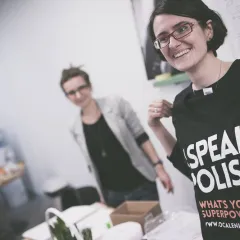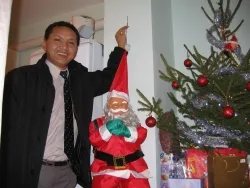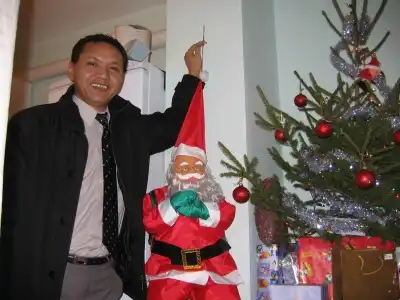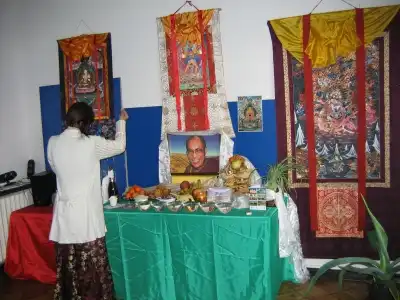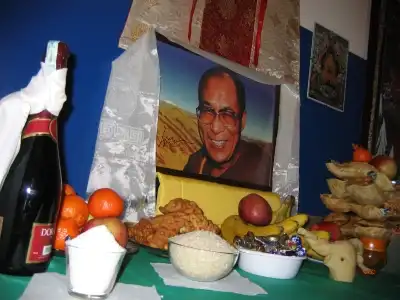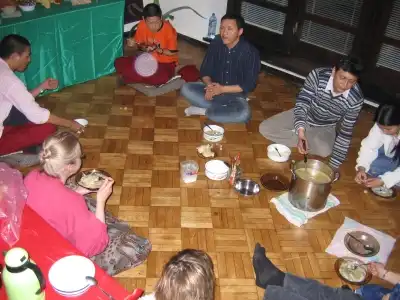The word „święta” (holidays) as it is beautifully called in Poland, has the same meaning as the Tibetan word „DHU CZEN”, which stands for 'big time'. The more it is connected with faith, the greater is the significance of a holiday. I think that on the whole, both Poles and Tibetans are religious, though the ways to perfection in these religions differ significantly. I am writing this feature article in December, that is in a month of, in my opinion, the most important holiday for Poles and for all the Catholics in the world. It would be a sin not to start with it. Once Tibetans were totally isolated from the rest of the world. Nowadays, since the Chinese occupation in 1959, they are dispersed all over it. Some people call it maliciously a 'bad karma' of Tibet (a phenomenon of reasons and results) and the good one of the outside world. That means that the rich tradition and culture of Tibet became really known among people outside its borders only after many thousands of Tibetans had defected because of the Chinese occupation.
I dare not jugde it myself, but I appreciate very much the fact that I have lived to see my country battle to survive and preserve its rich culture and tradition. I learn to respect the different traditions of other nations. One of them are Poles among which I have been living for more than 15 years.
During all this time I got to know Poles so well that I could not put them down by not celebrating the joyful Christmas.
Every year I get the invitation from my old friends (distant parents of my wife) for the solemn Christmas Eve. I take my whole family and... loads of gifts. I love to sit at the Christmas table with so many delicious dishes that I can hardly hide my appetite for. For me it's time of ideal feast. Many times I used to play Santa Claus from Himalayas and start singing Christmas carols. Most of my Tibetan collegues celebrate Christmas with their families and friends in a very similar way.
If I were to compare this holiday with any of ours, Tibetan New Year's celebrations – Losar ( Lo – a year, Sar – new ) come the closest, mostly by the way of preparing for them and celebrating. As far as the meaning of this holiday is concerned, without hesitation, the most appropriate Tibetan one would be the most important Buddhist holiday - ( Tibetan SAKADAWA ), which lasts for the whole fourth month of the year. For Tibetans it's the month of three most important Buddhist events – the birth, the enlightenment and the death of historical Buddha.During these typically religious holidays, Tibetans focus mainly on reflection on their own and other living creatures' lives and on an intensive practice of purifying their conscience or diminishing of the results of their negatives acts. They do it by intense prayer, giving material goods to the poor or by a few weeks' pilgrimage to holy places. Many Tibetans fast from morning till evening for the whole fourth month. They don't eat meat and don't wear any jewellery. Many beggars look forward to this holiday because there are so many helpful people then.
You can easily feel the atmosphere of New Year's celebrations more than a month before – it's the same thing with shopping fever before Christmas in Poland. Tibetans buy gifts mainly for children, adults give each other fabrics for new national dress – CZUBA, and buy various accessories, from cheap ornamental fabrics to very expensive jewellery of gold, silver and precious stones (coral, turquoise, amber, and stones with eye pattern known as ZHI). Wearing old clothes during New Year's Eve means dealing with old mundane problems.
All the people wearing new clothes are elegant and the girls are especially beautifil and atractive. That's why it's good time to look for lifetime partners because in everyday life you don't wear all this jewellery. There are many occasion for social contacts, firstly all the people celebrate in groups, secondly young people dance together through the whole night for many days, taking part, girls and boys and sometimes inhabitants of other villages and towns, in various competitions.
A dozen of so days before holiday people prepare special cookies of various shapes. The most characteristic are large ones called donkey ears. They are put one on another (about 20) on the home altar till the little tower is formed ( Tibetan Christmas tree ).
This small tower is trimmed with special decoration and glittering lamps. On the New Year altar you should also find : a sculptured ram head as a symbol of happiness, a pot with a newly planted barley – a symbol of good farming, a plate of barley and Tsampa ( basic Tibetan food similar to flour made of roasted barley) as a symbol of abundance of food, a bottle of freshly distilled home- made barley liquor called CZANG – a symbol of good luck, a jug of holy water – a symbol of a life of all living creatures and beside that all bowls full of fresh or dried fruits and sweets.
The two last months of the passing year are the most important in preparation to New Year's celebrations. The last but one day, the twenty ninth day of the month is connected with the ritual of chasing away of the doer of all evil in the passing year and it takes place during the supper when a special dense soup with dumplings is eaten. This supper is liked especially by members of the family because they can find in the soup little balls of dough with things and names of animals hidden inside them. These things can tell what the person would be like in the coming year. You can find such things as : cotton wool (white and pure conscience),a piece of coal (dark and foggy conscience), a piece of paper (changing and light), a piece of wood (strong and showy), chili ( quarrelsome and grumbling), a pig (lazy and suppressed intelligence), a cock (greedy and sexually excited), a snake (unfriendly and selfish), a hare (quick and wise) and so on.
At supper each member of the family is given one ball and then starts the play of teasing each other during the whole evening. In the middle of the house there is a flat bowl with a sculptured demon on it. Each member of the family ends the supper by pouring out the rest of the soup on the demon praying that it takes away all evil of the passing and coming year. Then one man carries the demon out of the house and everybody spits at him and shout that goes away. It is thrown away the furthest possible, at the crossroads of three ways where it is burnt down. It is important that the person carrying the demon not turn around till he returns home because this would mean showing the way back to evil.
The last day is spent of one's own hygiene and decorating home. It's a day of waiting for the New Year to come. This evening people go to sleep much earlier because at noon they wake up to celebrate.
Traditionally we start the celebration of the first day of the year just at noon by sharing New Year wishes in front of the decorated altar. Then we sit down at the table to eat the first meal – holiday dishes and everybody is given one cooked ram head as a symbol of happiness and good luck in the new year. Later on, children are given gifts and adults pay visit to relatives, neighbours and friends to wish them Happy New Year in front of the altar – a bit of Tsampa is thrown up in the air while the wishes are told. To mark them, Khatag is offered for the altar and a dot of Tsampa is put on the head of the family's left shoulder. After that the guest is invited to the table to join the meal.
From the early afternoon hours various games start. For the next two days families invite themselves to their home to feast. In Tibet New Year is celebrated for at least 7 days during which many pompous games with dances, dexterity, archery and horse competitions take place. On the fourth day common prayers to Buddha and local deities and hanging of the prayer flag start the next holiday called the Big Prayer Holiday (Tibetan MONLAM CZENMO). The oficial celebration of the New Year ends on the fifteenth day. This day is celebrated as a rememberance of magical acts of Buddha Sakjamuni.
We, Tibetans in Poland, celebrate this holiday rather modestly, for one or two days. Now, according to the Tibetan calendar it is the royal year 2136. In 2010, the Tibetan New Year of the Iron Tiger 2137 will fall on the fourteenth of February so we will have the double holiday (New Year and Valentine's Day ) on the same day. We are very happy to have the occasion to celebrate many Polish and Tibetan holiday in Poland.
Text by Yeshi
Translated by Agata Bogucka




